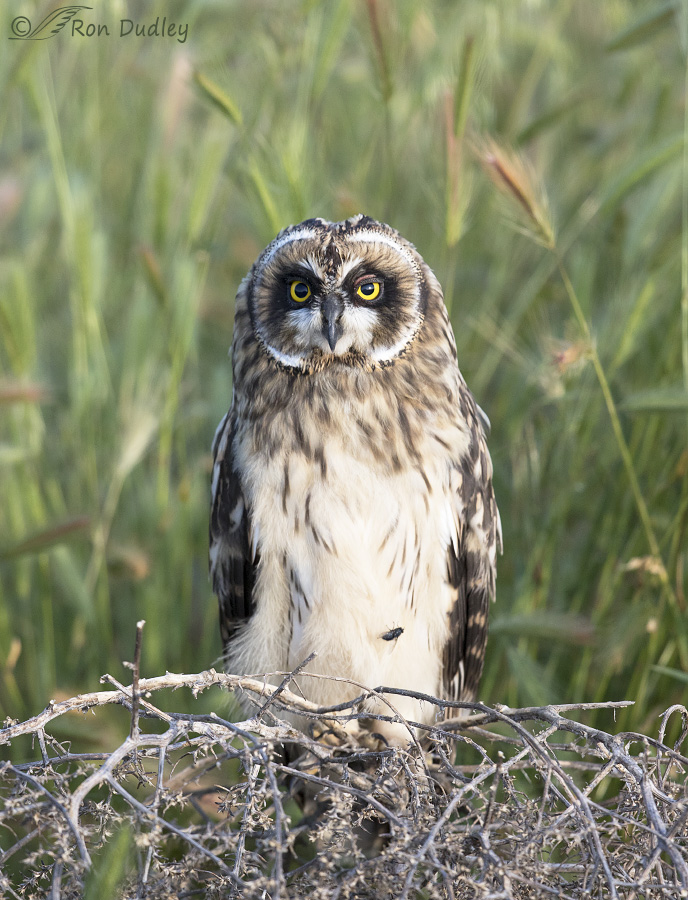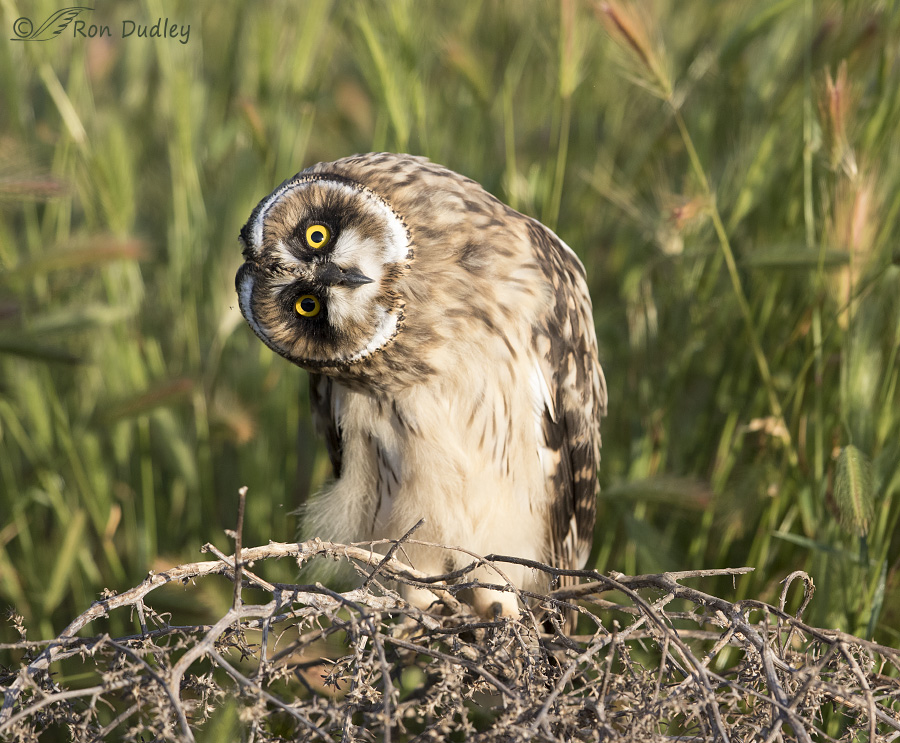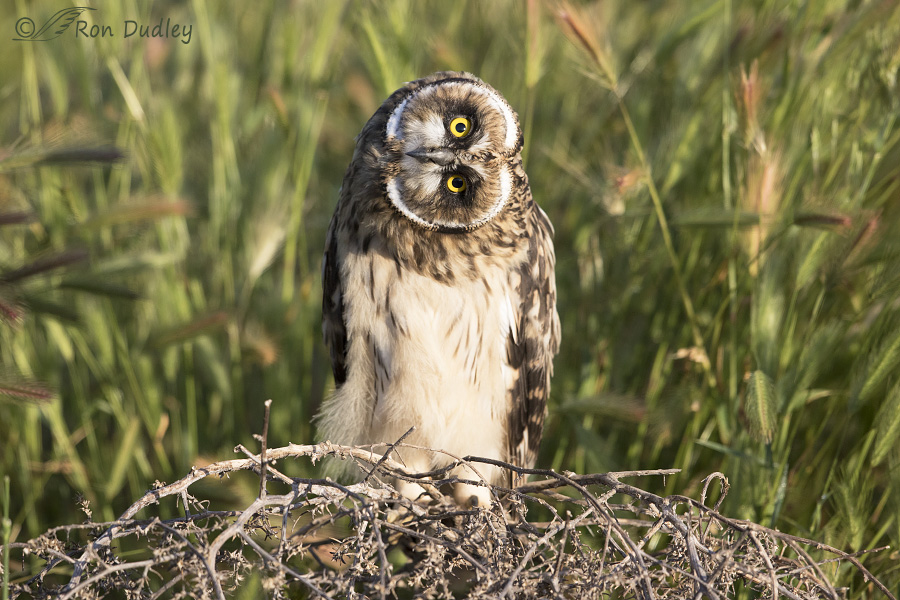For most folks very young owls have oodles of appeal and for me fledgling Short-eared Owls are at the top of the list.
“Shorties” are known to be highly nomadic from season to season. So far this year I’ve seen very few of them compared to a year ago and I’ve struck out completely on youngsters. I’ve really missed seeing them so this morning I’m posting some images taken in northern Utah about a year ago – on May 30, 2016.
1/1250, f/7.1, ISO 400, Canon 7D Mark II, Canon EF 500mm f/4L IS II USM, not baited, set up or called in
This recently fledged youngster was perched along the side of a road on an old tumbleweed. It seemed oblivious to any danger from passing vehicles and I was concerned for its safety and actually hoped that my presence would cause it to move to a safer location but it didn’t (as far as I know it survived being so close to the road).
It was also oblivious to the fly on its belly but it was extremely interested in my pickup and the clicking sounds from my camera.
1/2000, f/7.1, ISO 400, Canon 7D Mark II, Canon EF 500mm f/4L IS II USM, not baited, set up or called in
And as young owls in particular are prone to do it used parallax on me by rotating its head in a most endearing manner. I believe it was honing in on the clicking sounds from my camera because parallax activity seemed to increase when I was taking photos.
1/2500, f/7.1, ISO 400, Canon 7D Mark II, Canon EF 500mm f/4L IS II USM, not baited, set up or called in
It repeatedly rotated its head so far in both directions that I marveled at the flexibility of its neck (I always do when I see parallaxing owls). Owls have unique anatomy that allows them extreme flexibility of the neck without interfering with blood flow to the head.
Sharp eyes will notice how much warmer the light is in the second and third images as compared to the first. These shots were taken just after 7 AM and the first one was taken only 7 minutes after the others – light quality can change very fast.
I wish I had more room at the top of this image for better composition but I just don’t.
1/640, f/8, ISO 400, Canon 7D, Canon EF 100-400mm f/4.5-5.6L IS II USM @ 153mm, not baited, set up or called in
This owl wasn’t alone. A much darker sibling was perched on a pile of dirt just a few feet away and as you can see that one was playing the parallax game too.
There’s still time to see fledgling Short-eared Owls this year (we rescued Galileo off the barbed wire a year ago next week) and I hope I do but if it doesn’t happen perhaps that means most of the owls are nesting in more remote areas this year. If so there should be less danger from vehicles and barbed wire fences.
Ron






Precious!
They are absolutely enchanting.
I have to admit that I find almost any young bird (once they have fledged) or animal more appealing than the young of our own species. Perhaps a shameful admission, but true.
This is just plain ‘cuteness’!! The photos made me smile this morning….love them. Thanks, Ron
I agree, Alice. For me these birds personify “cuteness” – much more than when they’re significantly younger.
It truly is endearing. Loved this.
Thank you, Arwen.
Boy, do I wish my neck could bend even a tenth as easily as that little owl’s! He’s a hoot — and this is a most welcome re-post! And although we’d all like to see more of these comical kids, it’s nice to think they may be less visible this year because their nests are in safer locations.
“Boy, do I wish my neck could bend even a tenth as easily as that little owl’s!”
So do I, Chris. That would be very useful in certain situations for a bird photographer.
Actually, this isn’t a repost. I’ve posted other images of these birds but these are new to my blog.
They are adorable. I hope to photograph a juvenile one day too.
Thanks, April.
These shots gave both of us a good laugh this morning. There’s something about a parallaxing Owl that is irresistible. I also love the fly in the first shot.
“I also love the fly in the first shot”.
Good! I was hoping it wouldn’t put folks off. Musca domestica tends to do that in many contexts. I like it too.
Delightful! Hope you still get to see a few this year.
Me too, Marty. Me too!
I was lucky enough to find a pair this past week and one “sat” for a portrait before taking off for “Volefast” early in the a.m. I love how they look down while flying to find a vole. I heart them. Your photos are always completely amazing (even when your high standards tell you that certain shots are less perfect.) Thanks for posting.
Congrats on your cooperative owl, Doogs. I appreciate the comment.
Short earred and Burrowing owls always give me the laugh my parched soul needs so badly!!! THANK YOU!!! Love the parallaxing….
I feel the same about them, Patty. Thanks.
Of course, I love these cute owls, but all the different textures in the last photo is also interesting to me.
Good point about that last shot, Ann. Thanks.
Amusing and charming, thank you for sharing Ron. Gotta love them Shorties!!
Thanks very much, Zaphir.
Love these, Ron! Given owls’ ability to detect a vole beneath the snow, do you think they engage in the parallax tilts to that degree while in flight, too? Thanks.
Alison, if they do I’ve never seen it and I’ve spent a lot of time watching them hunting on the wing.
Love, love, love the parallaxing Shorties! Wonderful way to start the day!
I’m glad you like them, Diane. Thanks.
Marvelous shots Ron!
Charlotte
Thanks, Charlotte.
LOVE young owls of any sorts 🙂 They brighten my day with their clutzy movements and doing the parallax thing. The GHO’s we have here are having a hard time at the moment – bad weather and they want to be in the yard but getting in early enough and holding still enough so the Robins and everything else don’t see them is a challenge………..:) Thx for pulling these up again.
I envy you your GHO’s, Judy. I haven’t photographed young ones since my last trip to the Montana farm.
There is a family at the Cemetery in GF we saw last week. I was surprised as the male had a vole during the day and took off towards the others! Butt shots, of course! 🙁
I can’t help it–“adorable and funny” is the only way I can characterize your captures here– I laughed out loud at 6:30 AM, which I ‘ve never done before ! Great start to MY day– thanks !
Agreed, it’s hard to laugh at that hour of the morning! Thanks, Kris.